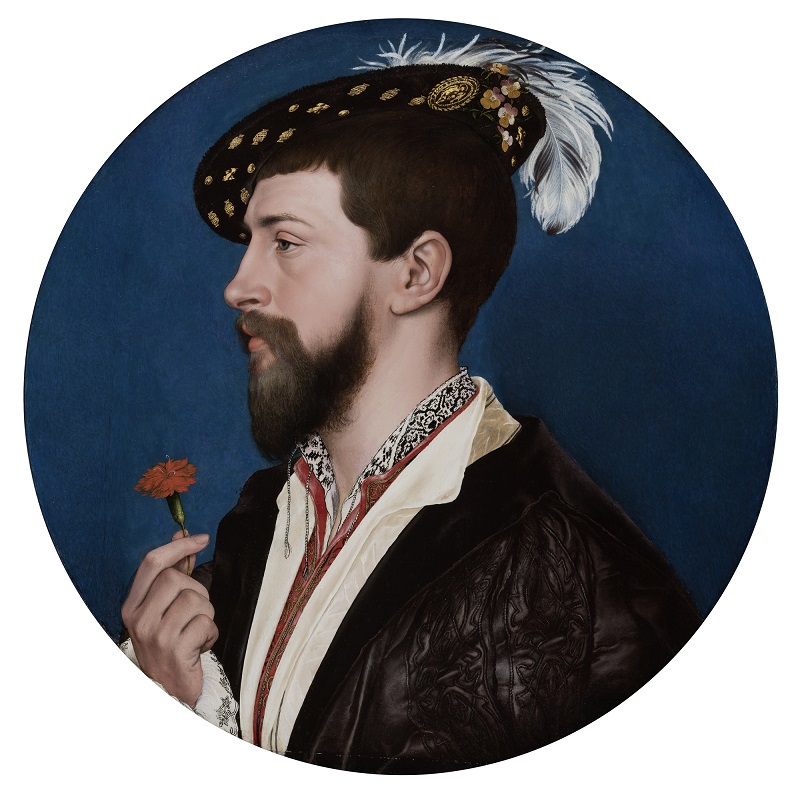Hans Holbein the Younger, one of the greatest artists of the Northern Renaissance, is being celebrated in a beautiful exhibition now on view at the J. Paul Getty Museum in Los Angeles.
Amazingly, it’s the first major retrospective of the German master’s work ever mounted in the United States and is co-organized with the Morgan Library & Museum in New York, where the show opens in February 2022. It features more than 50 works, mostly portrait paintings and drawings, but also designs for metalwork such as badges and medals and a handful of related works by other artists from the period.
Holbein (1497/98-1543) was born in Augsburg, Germany, the son of a successful painter. He moved to Basel, Switzerland, as a young man and began building an artistic career as the Protestant Reformation swept over Northern Europe.
His 1519 portrait of Bonifacius Amerbach (top image), one of the earliest in the exhibition, already displays many of his signature features: the uncanny realism; the luminous, polished colors; the intensely serious expression of the subject, a professor of law at the University of Basel; the mostly black clothing; the typographical description of the subject, in this case in Latin, on a framed sign hung from a tree branch. Though the portrait is only about 12 by 11 inches, it powerfully conveys the idea that this is an important person.
Holbein first achieved fame with a series of paintings of Erasmus of Rotterdam, the humanist scholar and author of In Praise of Folly. And when Holbein decided to move to London in 1526, Erasmus recommended him to Sir Thomas More, an influential figure in the court of Henry VIII. This led to a stream of portraits of the members of the court, including an iconic picture of King Henry himself, as well as commissions to paint members of the English gentry and other prominent figures.

One such portrait of an aristocrat is A Lady With a Squirrel and a Starling (Anne Lovell?) of 1526-28. The painting, which dates to Holbein’s early years in England, may depict the wife of Sir Richard Lovell of Norfolk and celebrate the birth of an heir. In any case, the young woman in black, wearing a white hat and shawl over her shoulders, presents a memorable image. The starling behind her right shoulder seems to be whispering into her ear as she looks to the side in a three-quarters pose. Incongruously, she also holds a chained pet squirrel in her lap. (The squirrel, an element in the Lovell family crest, was added to the portrait after it was virtually complete.) The meaning of it all is far from clear, but the work clearly conveys the serious, almost sad personality of the woman.
Holbein returned to Basel in 1528 and then back in London for a second time in 1532, where he became part of the circle around Anne Boleyn, King Henry’s second wife. He also completed a fine series of portraits of German merchants from the Hanseatic League who were living in the Steelyard area of London. (The exhibition includes four portraits of the stylish young men.)

Holbein’s 1532-33 portrait of Thomas Cromwell, at the time a member of Parliament and the King’s Privy Council, is one of the artist’s most powerful works. It shows the great man in a fur-lined coat, with a large emerald ring on his left forefinger, seated at a table covered in green cloth that’s strewn with papers and a book. Cromwell appears intensely serious as he looks off to the side, as if seeing something worrisome in the distance. A few years later, he fell out of favor with the king and was executed for treason and heresy in 1540.

Another portrait of an aristocrat, Simon George of Cornwell, from about 1535-40, presents a more lighthearted subject. Shown in profile in an unusual round format, like a coin, the elegantly dressed young man is quite a dandy. With a white feather in his hat and a red carnation in his right hand, he seems ready to propose marriage to his sweetheart. The exhibition also includes an interesting preparatory drawing of Simon George, this time without the feather, the flower, or even his beard.
Holbein survived the downfall of Anne Boleyn, becoming King’s Painter to Henry, and traveled back to Basel and other continental cities for commissioned work. He died in London in 1543, from an infection or possibly the plague, at the age of 45.
Visitors to the exhibition get an extra treat at the end of the show. Right next to the Holbein paintings is an excellent multi-gallery survey of 19th-century art in the Getty’s permanent collection. Like the Holbeins, it’s not to be missed.
Holbein: Capturing Character in the Renaissance runs through January 9, 2022, at the J. Paul Getty Museum, 1200 Getty Center Drive, Los Angeles. The exhibition will be on view at the Morgan Library & Museum in New York from February 11 through May 15, 2022. An extensive catalog is published by the Getty Museum.
Top image: Hans Holbein the Younger, Bonifacius Amerbach, 1519, mixed technique on panel, Kunstmuseum Basel, Amerbach-Kabinett.
